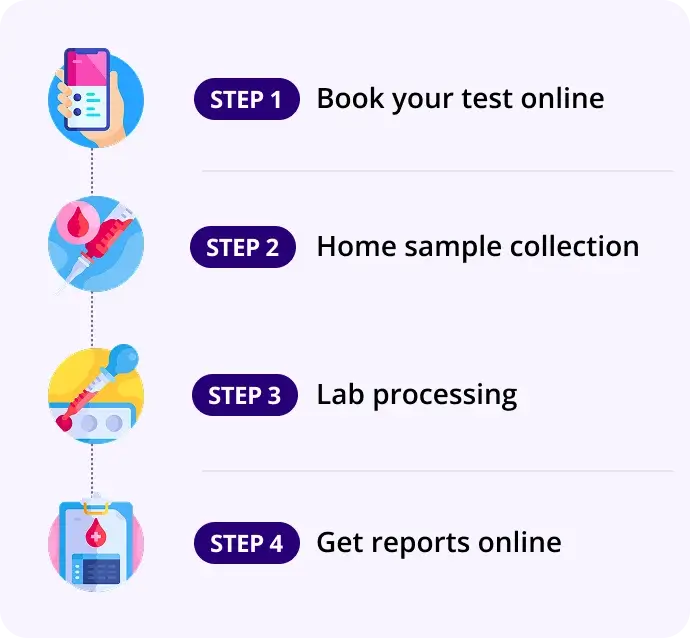Apo B/Apo A1 ratio
Report in 16Hrs
At Home
Fasting Required
Details
The ratio reflects the balance of harmful vs. protective cholesterol carriers and is a stronger predictor of heart disease than traditional lipid tests like LDL alone.
₹549₹990
45% OFF
Apolipoprotein B / Apolipoprotein A1 (Apo B: Apo A1) Ratio
| Parameter | Details |
|---|---|
| Also Known As | Apo B/Apo A1 Ratio, Apolipoprotein Ratio |
| Sample Type | Blood (Serum) |
| Fasting Required | ✅Recommended (8–12 hours for best accuracy) |
| Method | Immunoturbidimetry / Nephelometry |
| Turnaround Time | 1–2 days |
What Is the Apo B: Apo A1 Ratio?
This test measures the balance between atherogenic (bad) and protective (good) lipoproteins:
Apolipoprotein B (Apo B) is the main protein component of LDL, VLDL, and IDL, which are linked to plaque formation and cardiovascular risk.
Apolipoprotein A1 (Apo A1) is the main protein in HDL, involved in cholesterol removal and anti-inflammatory action.
👉 The ratio reflects the balance of harmful vs. protective cholesterol carriers and is a stronger predictor of heart disease than traditional lipid tests like LDL alone.
Organs/System Involved
| Organ/System | Role |
|---|---|
| Heart and blood vessels | Reflects risk of atherosclerosis and coronary artery disease |
| Liver | Produces both Apo B and Apo A1 proteins |
Why Is This Test Done?
| Purpose | Use Case |
|---|---|
| Evaluate cardiovascular risk | More accurate than LDL/HDL ratio alone |
| Monitor lipid-lowering therapy | Tracks response to statins or lifestyle changes |
| Detect atherogenic dyslipidemia | Especially in patients with metabolic syndrome or diabetes |
| Assess residual risk after statin use | May identify patients with "normal" LDL but high Apo B |
Interpretation of Results
| Apo B:Apo A1 Ratio | Cardiovascular Risk |
|---|---|
| < 0.6 (ideal) | Low risk |
| 0.7 – 0.9 | Moderate risk |
| > 0.9 | High risk |
The lower the ratio, the better the balance between good and bad cholesterol particles.
Associated Conditions
| Condition | Relevance |
|---|---|
| Coronary artery disease (CAD) | Higher Apo B:A1 linked to increased plaque risk |
| Diabetes / Insulin resistance | Often have elevated Apo B:A1 ratio |
| Metabolic syndrome | Imbalance in atherogenic and protective lipoproteins |
| Familial hyperlipidemia | Used for screening in genetically predisposed patients |
Recommended Further Tests
| Test | Why It's Useful |
|---|---|
| Lipid Profile (Total, LDL, HDL, TG) | Traditional assessment of cholesterol balance |
| hs-CRP | Measures inflammation linked to cardiovascular risk |
| Lipoprotein(a) | Independent risk factor for heart disease |
| Homocysteine | Amino acid linked to endothelial dysfunction |
| Fasting Blood Sugar / HbA1c | Check for diabetes/metabolic syndrome |
| Coronary Calcium Score (CT) | Advanced imaging in high-risk individuals |
Who Should Get This Test?
Individuals with:
o Strong family history of heart disease
o High cholesterol or triglycerides
o Diabetes or metabolic syndrome
o Unexplained high LDL with normal total cholesterol
People already on statins who want residual risk assessed
Summary Table
| Test | Apo B: Apo A1 Ratio |
|---|---|
| Used For | Cardiac risk assessment |
| Organ/System | Cardiovascular, liver |
| Fasting Required | ✅ Yes (8–12 hrs) |
| Interpretation | Lower is better (<0.6 = low risk) |
| Common Add-on Tests | Lipid Profile, hs-CRP, Homocysteine, Lp(a), HbA1c |
| Associated Conditions | CAD, diabetes, dyslipidemia, metabolic syndrome |
How our test process works!

